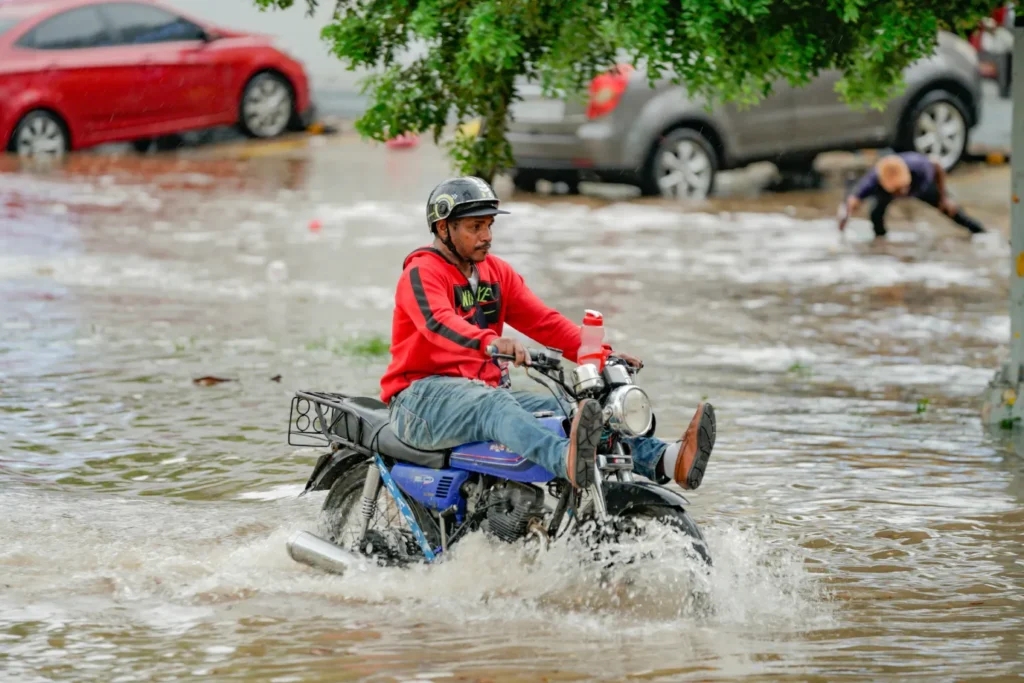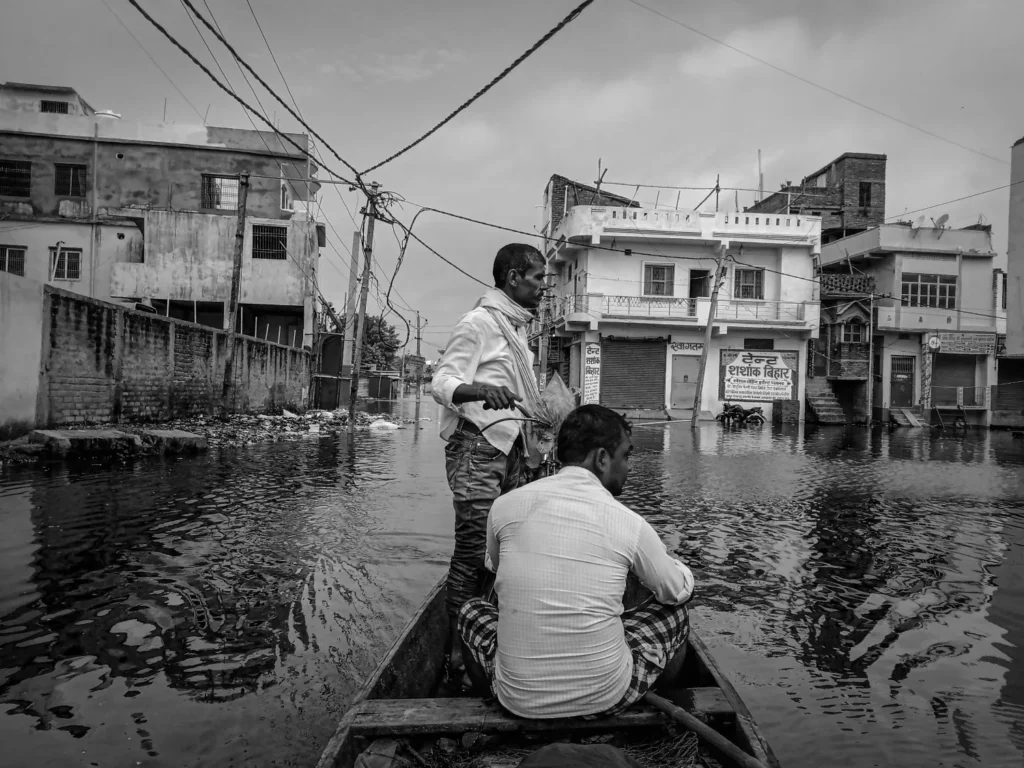Introduction:
By September 2025, the worst floods in almost four decades in Punjab had inundated approximately 3 lakh acres of farmland in 23 districts, due to which the state had been declared disaster-hit. Crop damage is estimated in crores of rupees (Honycontroller, The New Indian Express, The Times of India, India Today, Indian Express).
These floods have profoundly impacted not only agriculture and infrastructure but also urban dynamics. Urban planning, buyer sentiment, and property values are all adjusting.
1) Flood-Prone Zones: Risk Perception and Changes in Buyer Behavior

If urban areas like Kharar are considered, construction has occurred on natural drainage systems and once-seasonal streams. The unchecked urbanization has made flooding even more devastating, according to a September 20, 2025, report by The Indian Express. In such areas, buyers’ sentiment is now shifting—people are now compromising on prices and shifting to avoid these areas. Historically, the immediate impact of floods on property prices is visible in India; an example is research from Italy, where a 12% price decline was observed in frequently flooded regions, albeit with India-specific data.
Read More : Punjab Floods 2025: Real Estate Market Impact Analysis & Investment Guide
2) Safe Zones are Becoming Highly Sought After—Elevated & Better-Drained Areas!
In the case of Lahore (though on the Pakistan side, the context is comparable), developers and buyers have shown a shift towards safe zones that are either elevated or away from rivers. Flood-resilient societies are in high demand, while luxury projects in flood-prone areas are being discounted (Arzday Pak.com, Your Real Estate Experts). A similar pattern is emerging in Punjab: buyers are moving to areas with higher altitudes or better infrastructure.
3) Financial Damage and Real Estate Value:

Punjab floods caused severe damage to farming and rural households. Hundreds of crores in crop loss, housing losses, and public property damage. 316 houses were totally damaged, 1288 partially damaged. Total property damage is up to crores in damage (The Indian Express). Infrastructure was also severely damaged: over 3050 km of roads washed out, along with border outposts and fencing (The Times of India, The Indian Express). These losses are likely to temporarily depress rural property values, especially in areas lacking flood resilience infrastructure.
Read more : Top Government Housing Schemes for First-Time Home Buyers in India (2025)
4) Short-Term Spike in Demand for Relief-Reliant Assets:
An interesting uptick has been seen in demand for boats, life jackets, and rescue tools—even among civilians. Gurudwaras, local communities & policymakers are receiving 150 calls/day—boats cost Rs. 85,000–1.80 lakh; life jackets cost Rs. 1,000 (India Today). While this is strictly not a real estate product, it highlights that communities stressed during floods want resilient assets indirectly. This sentiment filters into safety & resilience in real estate demand.
5) Policy response and real estate risk awareness:
Illegal sand mining and embankment weakening have increased the severity of floods, the Union Agriculture Minister emphasized, and he told the state government to take serious action. (The Times of India). The extension of the awareness is reaching the real estate sector—it now seems necessary for builders and regulators to include flood-proof planning (like concrete bunds, drainage, and zoning).
Sadhar leaders have pushed for concrete embankments, which will make future urban expansions more resilient (The Times of India).
6) Broader Macro Impact: Inflation, Public Distribution System (PDS) Procurement, and Real Estate:

Floods have severely impacted the agriculture sector, and there’s a looming risk of price inflation for paddy and vegetables. PDS procurement may be affected (Moneycontrol, The Tribune). If flood prices spike, urban budgets will be strained, and disposable incomes will be impacted—this will dampen property demand. Reliance will increase on real estate, long-term resilience, affordable housing, and mixed-use planning.
Read also : Plots for Sale Near Me — Find the Best Deals & Investment Opportunities
7.Market Expert Analysis and Industry Response:
Leading real estate consultants in Punjab report a 25-30% increase in inquiries for properties in elevated areas post-floods. Gurpreet Singh, a prominent Chandigarh-based realtor, notes, “Clients are now specifically asking about flood history and drainage systems before viewing properties.” Major developers are now incorporating flood-resistant features as key selling points in their marketing campaigns.
Real estate analyst Manpreet Kaur from Knight Frank India observes, “The Punjab floods have accelerated a trend we’ve been tracking—climate resilience is now a primary factor in property valuation, not just location and amenities.”
8. Summary Table – Key Impacts
| Aspect | Impact on Real Estate |
| Flood-prone zones | Risk-sensitive pricing, depreciation, buyers avoid investing |
| Elevated/safe zones | Stable or rising demand, scope for premium on resilience |
| Rural peripheral properties | Property values dip, loss of confidence unless reconstruction and embankments improve infrastructure |
| Disaster response assets | Surged demand for local relief gear reflects community focus on preparedness; long-term may reflect preference for resilience features |
| Policy and regulation | Need for zoning reforms, embankments, disaster-sensitive planning; future developments likely constrained by flood risk mapping |
| Macroeconomic impact | Agriculture hit → inflation → reduces purchasing power, dampens real estate demand, spurs demand for affordable resilient housing |
| Community sentiment | Long-term ownership ethos remains, but short-term skepticism mounts in flood zones; “no crash” trend persists |
Conclusion – The Punjab floods of 2025 have brought a paradigm shift in the real estate market. In the past, luxury locations were simply locations, but today, safety, drainage, and flood resilience have equally become value factors. The values of flood-prone areas may dip in the short term, but the premium for safe, elevated zones will increase. A policy push for embankment resilience infrastructure and land-use regulation is expected. And consumer behavior? It was anchored in the long-term belief in property as security, but now filtered through the lens of climate risk. Real estate players will need to align with this shift—design planning, build with water-sensitive strategies, and price wisely.
Frequently Asked Questions (FAQ)
-
Q1: How have Punjab floods 2025 impacted real estate prices?
👉 Real estate prices in flood-prone zones have declined, while demand is rising for elevated and safer areas. Buyers now prioritize flood-resilient locations.
-
Q2: Which areas in Punjab are safer for property investment after the floods?
👉 Elevated regions with better drainage and flood-proof infrastructure, such as parts of Chandigarh periphery and higher-altitude zones, are currently in demand.
-
Q3: What steps are being taken to make Punjab’s real estate more flood-resilient?
👉 Builders and policymakers are focusing on better drainage, concrete embankments, and stricter zoning laws to ensure future housing projects can withstand climate risks.
-
Q4: Is it safe to invest in Punjab real estate after the 2025 floods?
👉 Yes, but with caution. Investors should focus on flood-safe zones, elevated properties, and projects that highlight climate-resilient features like strong drainage systems.
